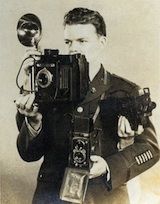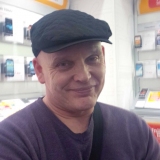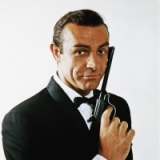- Forum
- General Discussion | Introductions | Off Topic Forum
- Photography General Discussion
- Shock-inducing photography: is it ethical?
Shock-inducing photography: is it ethical?
-
 Topic Author
Topic Author
- arvindpassey
- Lone Wolf
-
- Sony DSC H2 and Nikon D5000
- Followers: 110
- Posts: 127
-
Points:
0
Post #74953
-

- MLKstudios
- Banned
-
- D800 ;-)
- Followers: 72
- Posts: 4480
-
Points:
2
Post #74963
As for should "shocking" photos be taken, or even seen? That's a dilema for any journalist. If someone is being hurt, do you stop and help them, or keep shooting? Each individual has to decide for themselves.
Then once those photos are made, should the publisher publish them? Maybe they are shocking enough to stop a war, or point out an area to the world that is in dire need of help. That depends on how they are presented and also, who is viewing them.
There isn't a simple answer. If we allow censorship, then some truth might get hidden from us. If we don't show the world their faces, will they know what happened? Is symbolism enough for everyone? Some people need a slap before they grasp the reality.
I guess my point is there is no answer to your questions. We each have to decide what is acceptable to us. We can always chose NOT to look. But, I think it would be wrong to hide the truth for moral, ethical or any other reason you can think of. Photography is about life and death, war and peace, happy and sad. It is EVERYTHING. Even those things that aren't pretty.
Matthew
Matthew L Kees
MLK Studios Photography School
www.MLKstudios.com
[email protected]
"Every artist, was once an amateur"
-
 Topic Author
Topic Author
- arvindpassey
- Lone Wolf
-
- Sony DSC H2 and Nikon D5000
- Followers: 110
- Posts: 127
-
Points:
0
Post #74965
However, would governments, people in power, nations, politicians, bureaucrats, the sermon-gushers, the advisors, and their like agree with this pov?
MLKstudios wrote: Ethical or not, human beings will do ANYTHING if it is possible. That includes going to the moon, or human cloning. Others can argue the moral, ethical and legal points, but it won't stop someone from doing so. It's what history has shown us what people do -- whatever they can.
As for should "shocking" photos be taken, or even seen? That's a dilema for any journalist. If someone is being hurt, do you stop and help them, or keep shooting? Each individual has to decide for themselves.
Then once those photos are made, should the publisher publish them? Maybe they are shocking enough to stop a war, or point out an area to the world that is in dire need of help. That depends on how they are presented and also, who is viewing them.
There isn't a simple answer. If we allow censorship, then some truth might get hidden from us. If we don't show the world their faces, will they know what happened? Is symbolism enough for everyone? Some people need a slap before they grasp the reality.
I guess my point is there is no answer to your questions. We each have to decide what is acceptable to us. We can always chose NOT to look. But, I think it would be wrong to hide the truth for moral, ethical or any other reason you can think of. Photography is about life and death, war and peace, happy and sad. It is EVERYTHING. Even those things that aren't pretty.
Matthew
-

- MLKstudios
- Banned
-
- D800 ;-)
- Followers: 72
- Posts: 4480
-
Points:
2
Post #74967
We have the ability to make art, and help one another as much as we have the ability to kill. It's too bad politics (and religion) sometimes makes those decisions for us. Once we realize our own humanity, it is much easier to find in others, in ALL nations.
Politicians (and some religious leaders) need to discover that for themselves as well.
Matthew
Matthew L Kees
MLK Studios Photography School
www.MLKstudios.com
[email protected]
"Every artist, was once an amateur"
Post #74971
The photographers had their cameras on the ready, they were at work and they - as far as I see it - continued to do their job, even as the world around them was turned upside down and inside out.
Or how about Emilie Hudig , who chose to take photos of her cancer, also a winner in 2009?
A user friendly computer first requires a friendly user.
-

- MLKstudios
- Banned
-
- D800 ;-)
- Followers: 72
- Posts: 4480
-
Points:
2
Post #74977
There have been more than a few American photographers who've covered their own diseases quite explicitly, photographically, and that seems to have more acceptance over here. I believe they think it leads to a positive end -- i.e. a better understanding of the disease.
I remember the car "attack" on the news here. Do you have any idea of Mr. Tates' motives? They didn't show us the carnage as mentioned above. We only saw a car plowing into a crowd, more or less. Not a lot of details.
I'm sure you noticed my family name is of Dutch origin. More often a first name, not a last name. I lived in Amsterdam for awhile and find the people there to be incredibly civilized, even with the free drug use. Was kind of like our first Woodstock.
Matthew
PS I do think it important that photography is used to show us our world, including the good, the bad, and the ugly. It's not just cute kids and pretty flowers, it's all of life.
Matthew L Kees
MLK Studios Photography School
www.MLKstudios.com
[email protected]
"Every artist, was once an amateur"
Post #74979
MLKstudios wrote: American media does edit out gore in photos (excessive blood, etc.) and that can be construed as a type of censorship. I saw much more explicit photos when I lived in Europe. The stairways were steeper too. Just what you are used to, I guess.
There have been more than a few American photographers who've covered their own diseases quite explicitly, photographically, and that seems to have more acceptance over here. I believe they think it leads to a positive end -- i.e. a better understanding of the disease.
I remember the car "attack" on the news here. Do you have any idea of Mr. Tates' motives? They didn't show us the carnage as mentioned above. We only saw a car plowing into a crowd, more or less.
I'm sure you noticed my family name is of Dutch origin. More often a first name, not a last name. I lieved in Amsterdam for awhile and find the people there to be incredibly civilized, even with the free drug use. Was kind of like our first Woodstock.
Matthew
PS I do think it important that photography is used to show us our world, including the good, the bad, and the ugly. It's not just kids and flowers.
Mr Tate's motives remain uncertain, here is a speculation from the Telegraph .
Yes, perhaps we Europeans tolerate more gore and blood and "reality" both in our media and in our staircases.
And I agree with your PS, where
made me think of Anne Geddes , where I tend to prefer the parodies:It's not just kids and flowers.
parodies
A user friendly computer first requires a friendly user.
-

- photobod
- Paparazzi
-
- Nikon D800 + D300
- Followers: 563
- Posts: 8907
-
Points:
150
Post #75029
The above PS answers the question for me, then we have the choice to look or not, sorry I am not as intellectualy profound as others on here, so its the best I can do on this subject.
www.dcimages.org.uk
"A good photograph is one that communicate a fact, touches the heart, leaves the viewer a changed person for having seen it. It is, in a word, effective." - Irving Penn
-

- photobod
- Paparazzi
-
- Nikon D800 + D300
- Followers: 563
- Posts: 8907
-
Points:
150
Post #75035
Trudehell wrote:
MLKstudios wrote: American media does edit out gore in photos (excessive blood, etc.) and that can be construed as a type of censorship. I saw much more explicit photos when I lived in Europe. The stairways were steeper too. Just what you are used to, I guess.
There have been more than a few American photographers who've covered their own diseases quite explicitly, photographically, and that seems to have more acceptance over here. I believe they think it leads to a positive end -- i.e. a better understanding of the disease.
I remember the car "attack" on the news here. Do you have any idea of Mr. Tates' motives? They didn't show us the carnage as mentioned above. We only saw a car plowing into a crowd, more or less.
I'm sure you noticed my family name is of Dutch origin. More often a first name, not a last name. I lieved in Amsterdam for awhile and find the people there to be incredibly civilized, even with the free drug use. Was kind of like our first Woodstock.
Matthew
PS I do think it important that photography is used to show us our world, including the good, the bad, and the ugly. It's not just kids and flowers.
Mr Tate's motives remain uncertain, here is a speculation from the Telegraph .
Yes, perhaps we Europeans tolerate more gore and blood and "reality" both in our media and in our staircases.
And I agree with your PS, wheremade me think of Anne Geddes , where I tend to prefer the parodies:It's not just kids and flowers.
parodies
What a great parody watched it right through, I actualy remember seeing those photos come out and I hated them !!!!!
www.dcimages.org.uk
"A good photograph is one that communicate a fact, touches the heart, leaves the viewer a changed person for having seen it. It is, in a word, effective." - Irving Penn
-

- MLKstudios
- Banned
-
- D800 ;-)
- Followers: 72
- Posts: 4480
-
Points:
2
Post #75051
My heart goes out to all of Geddes "models".
Matthew
Matthew L Kees
MLK Studios Photography School
www.MLKstudios.com
[email protected]
"Every artist, was once an amateur"
Post #75641
-

- Baydream
- Moderator
-
- Canoni/60D/70D/5DmkIII
- Followers: 388
- Posts: 11185
-
Points:
7280
Post #75657
I think those that choose not to display gore and the like are doing so to be sensitive to the victims, but a some point there are cases when the display is aimed at a "higher cause". Many years ago, high school driver ed courses used to show the gore that accompanied tragic automobile wrecks. The purpose was to make young drivers think about what poor decisions can cause. I think others have done the same to further a cause they feel passionate about.
Television brought the Kennedy assassinations right before our eyes. We saw the planes slam into the World Trade Center on 9/11.
Things that are "hidden" from the public are bound to be repeated.
Shoot, learn and share. It will make you a better photographer.
fineartamerica.com/profiles/john-g-schickler.html?tab=artwork
-

- Scotty
- Agent 007
- James Bond, PT mod.
- Followers: 1088
- Posts: 9882
-
Points:
15011
Post #75681
Just because you can express the ugly parts of life, doesn't mean you have to though.
When the last candle has been blown out
and the last glass of champagne has been drunk
All that you are left with are the memories and the images-David Cooke.
Post #75739
Joves wrote: If someone asked me I would even shoot a funeral which to many is taboo, but as long as it isnt to the family then it wouldnt be a problem..
This image from foto.no won a part of a photography contest this spring.
[/i]The jury says:
This picture is left in memory. The composition gives both motion and energy, yet is a muted silence in the description of the situation. The photographer manages to say much about the human condition in a picture that is very honest and can be felt both sad and funny, without going into the post-treatment trap.
A user friendly computer first requires a friendly user.
-

- MLKstudios
- Banned
-
- D800 ;-)
- Followers: 72
- Posts: 4480
-
Points:
2
Post #75753
www.boston.com/bigpicture/2011/04/cherno...ter_25th_annive.html
Matthew
Note, the best journalism is not done with long lenses from far away, but short ones close in. It takes us there and wraps that world around us.
Matthew L Kees
MLK Studios Photography School
www.MLKstudios.com
[email protected]
"Every artist, was once an amateur"
- Forum
- General Discussion | Introductions | Off Topic Forum
- Photography General Discussion
- Shock-inducing photography: is it ethical?
Latest Reviews
The Panasonic G9 II is a 25.2-megapixel micro four thirds camera with numerous features that make it punch out of its weight class, like 779 AF points, 5.8K video, and weather sealing.
The Fujifilm XT5 is a 40MP mirrorless camera capable of 6.2K video at 30p. With those specs, it’s an ideal choice for photographers needing a camera to pull double duty for imaging and video.
The Canon EOS R100 is an entry-level mirrorless camera introduced in 2023. But just because it’s an entry-level camera doesn’t mean it’s a bare-bones camera. Find out why in this review!
Nikon’s retro-looking Nikon Zfc is anything but retro. Under its classic body is a host of features and amenities that make it a worthwhile compact mirrorless camera for 2024.
Forum Top Posters
-
1Scotty 6 posts
-
2TCav 6 posts
-
3Ruby Grace 4 posts
-
4Street Shark 4 posts
-
5Nefarious 3 posts
-
6Roger Lang 3 posts
-
7Carter Gledhill 2 posts
-
8Chris Briggs 2 posts
-
9Garbo 2 posts
-
10amirahusse... 2 posts
Latest Articles
Starting a photography business is one thing; sustaining your business over a long period of time is another. Use the tips in this professional photography guide to build something with longevity!
The Panasonic G9 II is a 25.2-megapixel micro four thirds camera with numerous features that make it punch out of its weight class, like 779 AF points, 5.8K video, and weather sealing.
Cinematic photography is an interesting genre that combines photographic and videographic skills along with effective storytelling techniques. The result? Highly impactful images!
Newborn photography requires skill, the right gear, and a lot of patience. This beginner’s guide discusses critical topics that will help you be more prepared for before, during, and after the shoot.
To fill the frame means to expand the footprint of the subject in your shot. Get in close, zoom in, crop the image, or use other techniques to bring the subject to the forefront.
With these simple yet effective beginner photography tips, you can avoid some of the common mistakes beginners make and get improved results with your images.
Urban photography is a genre showcasing features in urban settings. You can photograph people, architecture, mass transit, and many other subjects. Learn how to do so in this guide!
The Nikon D850 might be an older DSLR, but it was ahead of its time when it debuted in 2017. That means it still has plenty of firepower to compete with today’s powerful mirrorless cameras.


















